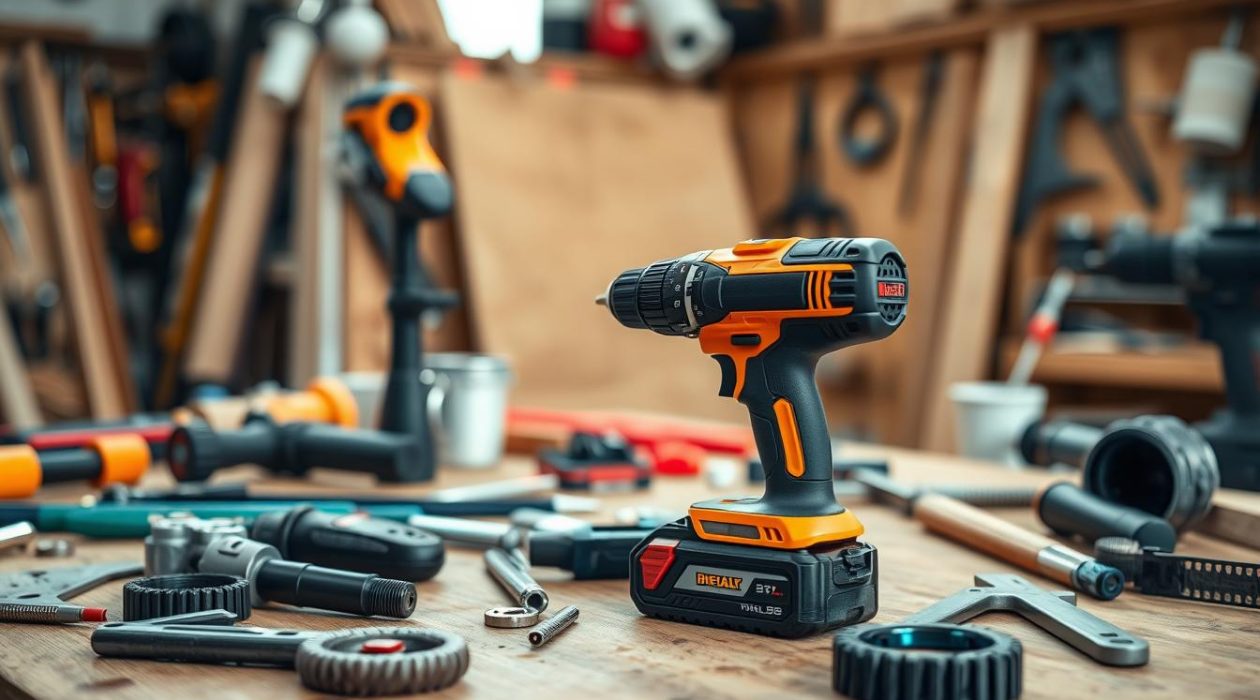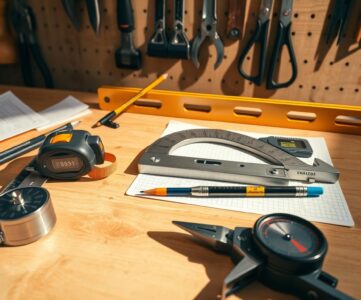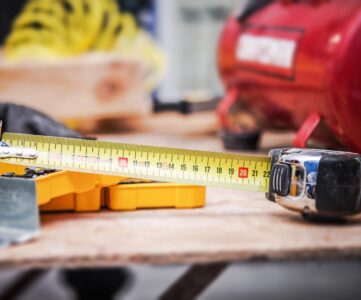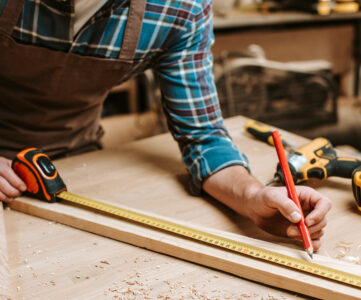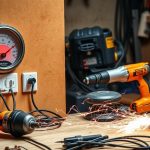For DIY enthusiasts, the right tools are crucial. A cordless drill is a must-have, with many options available. It’s vital to pick the perfect power drill for your needs, whether you’re a beginner or seasoned DIYer.
A cordless drill is versatile, suitable for drilling holes and driving screws. With so many choices, it’s key to understand each drill’s features and specifications. This article will help you choose the right drill, covering different types and what to look for when buying.
We aim to equip you with the knowledge to pick the best cordless drill for your DIY projects. We’ll discuss important factors like the drill type, features, and specifications.
Key Takeaways
- Consider the type of projects you will be working on to determine the right cordless drill for your needs
- Think about the features you need, such as speed and torque control
- Look for power drills with high-quality batteries and charging systems
- Check the weight and ergonomics of the drill for comfortable use
- Set a budget and consider the value for money when making a purchase
Understanding Different Types of Cordless Drills
Cordless drills have gained immense popularity for their convenience and portability. They are perfect for DIY enthusiasts. When deciding between a cordless and corded drill, consider the projects you’ll tackle. Cordless drills offer flexibility and ease, while corded drills provide consistent power.
There are various types of cordless drills, each with unique features and benefits. Drill drivers are versatile, suitable for drilling holes and driving screws. On the other hand, impact drivers are built for heavy-duty tasks, offering more torque than drill drivers.
Choosing the right drill for DIY projects is crucial. Consider these factors:
- Project size and complexity
- Material being worked with (wood, metal, etc.)
- Desired level of precision and control
| Drill Type | Features | Advantages |
|---|---|---|
| Drill Driver | Versatile, adjustable torque | Ideal for various DIY projects |
| Impact Driver | High torque, compact design | Perfect for heavy-duty applications |
Power Ratings and What They Mean
Choosing the right power drills for DIY projects requires understanding power ratings. The power rating of a cordless drill shows its capability for various tasks. These include drilling through wood and driving screws. Power ratings are measured in voltage, ampere-hour, and wattage.
A higher voltage cordless drill offers more power, ideal for tough tasks. Ampere-hour measures the battery’s energy storage capacity. A higher rating means the power drill can operate longer without needing a recharge. Wattage, the product of voltage and current, indicates the cordless drill‘s total power output.
- Voltage: A higher voltage cordless drill provides more power
- Ampere-hour: A higher rating means longer runtime
- Wattage: A measure of the power drill‘s overall power output
Understanding these factors helps you pick the right power drills for your projects. This ensures you have the power needed to finish your DIY tasks efficiently.
Battery Technology in Modern Drills
Choosing the right drill for DIY projects often hinges on the battery type. The cordless vs corded drill debate has seen cordless drills gain popularity for their ease and mobility. Yet, it’s the battery technology that truly distinguishes them.
Lithium-ion batteries have become the norm for cordless drills, replacing nickel-cadmium batteries. They offer better energy density, longer life, and less self-discharge. For DIY tasks, lithium-ion batteries provide the necessary power and dependability.
When picking a cordless drill, consider the battery’s voltage, charging time, and runtime. Higher voltage means more power but also heavier drills and higher costs. The charging time and runtime are key, ensuring the drill can handle your projects without constant recharging. Opting for the right battery technology ensures your DIY endeavors are done efficiently and effectively.
Lithium-Ion vs Nickel-Cadmium
- Lithium-ion batteries have a higher energy density
- Nickel-cadmium batteries have a lower self-discharge rate
- Lithium-ion batteries are more environmentally friendly
Understanding the differences between lithium-ion and nickel-cadmium batteries aids in making a wise choice for your cordless drill. With the correct battery technology, you’re ready to take on any DIY challenge with confidence and precision.
Essential Features to Look for in a Cordless Drill
When searching for a cordless drill, it’s vital to focus on key features that enhance your drilling experience. Power drills and cordless drill models differ in speed, torque, and clutch settings. These are crucial for various drilling tasks.
A quality cordless drill should offer adjustable speed settings. This allows you to tailor the drill’s speed to the material you’re working with. Torque settings are also critical, enabling you to manage the drill’s rotational force. A dependable clutch system prevents damage to the drill and the material around it.
Other important features include ergonomics, balance, and weight distribution. A well-designed handle and grip reduce fatigue and enhance control. The type of chuck and bits used significantly impacts the drill’s performance and versatility.
- Adjustable speed settings
- Torque settings
- Reliable clutch system
- Ergonomic design and balance
- Compatible chuck and bits
By examining these essential features, you can identify the ideal power drills or cordless drill for your needs. Whether you’re a DIY enthusiast or a professional contractor, finding the right tool is crucial. Always research and compare different models to ensure you’re getting the best value for your investment.
Understanding Chuck Sizes and Their Applications
When selecting between a cordless and corded drill for DIY projects, grasping chuck sizes and their roles is key. The chuck is the mechanism that secures the bit, influencing the drill’s performance and the types of bits it can handle. Different chuck sizes cater to various drilling needs, impacting the efficiency and precision of your work.
In DIY endeavors, the correct chuck size is vital. A larger chuck accommodates bigger bits, essential for heavy-duty drilling tasks. This highlights the importance of matching chuck size to the project’s demands.
Different Chuck Types
Several chuck types exist, including keyless, keyed, and quick-change systems. Each offers unique benefits and drawbacks, depending on your specific requirements and preferences. Selecting the appropriate chuck is crucial for optimal performance.
Choosing the Right Bits
Bit selection is equally critical. The material, size, and shape of the bit must align with the task at hand. For instance, twist bits are ideal for wood, while masonry bits are suited for concrete. The right bit ensures effective and accurate drilling.
Quick-Change Systems
Quick-change systems streamline the process of bit swapping, eliminating the need for a key. This feature is invaluable for projects requiring frequent bit adjustments, saving both time and effort.
| Chuck Type | Description | Advantages |
|---|---|---|
| Keyless Chuck | Does not require a key to change bits | Convenient, easy to use |
| Keyed Chuck | Requires a key to change bits | More secure, less likely to slip |
| Quick-Change System | Allows for quick bit changes without a key | Time-saving, efficient |
Speed Settings and Torque Control
In the realm of power drills, cordless models stand out due to their speed settings and torque control. These elements are pivotal, affecting the drill’s performance and versatility. They enable users to handle a variety of tasks efficiently. For example, variable speed settings allow for adjustments based on the material being worked with, whether it’s wood, metal, or plastic.
Torque control in cordless drills is equally vital, influencing the drill’s rotational force. This is crucial when dealing with large screws or hard materials. Adjusting the torque setting helps avoid material or drill damage. Some drills feature electronic torque control, offering more precise control over output.
The advantages of speed settings and torque control in power drills are numerous:
- Improved precision and control
- Increased versatility for various tasks and materials
- Enhanced safety features to prevent damage or injury
When selecting a cordless drill, assess the projects you’ll undertake and the required speed and torque control. Opt for a drill with adjustable speed settings and a dependable torque control system. This ensures you can confidently handle any task.
Ergonomics and Comfort Features
When deciding between a cordless and corded drill for DIY projects, ergonomics and comfort are key. A drill designed with these aspects in mind can reduce fatigue and enhance usability. This makes it easier to tackle tasks efficiently. Weight distribution is crucial, as it impacts the drill’s balance.
A drill with balanced design is easier to hold and maneuver, reducing strain on hands and wrists. Grip design is also important, as a contoured grip offers a secure hold and prevents slippage. Some drills come with adjustable handles, allowing users to tailor the fit to their hands.
Trigger Control and Vibration Reduction
Trigger control is essential, enabling users to adjust the drill’s speed and torque. A smooth, responsive trigger significantly enhances the drilling experience. Some drills also have vibration reduction systems, which lessen the impact of vibrations on hands and arms.
When choosing a cordless drill for DIY projects, consider these factors:
- Weight distribution and balance
- Grip design and comfort
- Trigger control and responsiveness
- Vibration reduction systems
By focusing on ergonomics and comfort, you can select a cordless drill that suits your needs and preferences. This makes DIY projects more efficient and enjoyable.
| Feature | Importance | Description |
|---|---|---|
| Weight Distribution | High | Affects overall balance and comfort |
| Grip Design | High | Provides a secure hold and reduces slippage |
| Trigger Control | Medium | Regulates speed and torque |
| Vibration Reduction | Low | Minimizes impact of vibrations on user |
Price Range and Value Considerations
The cost of cordless drills varies widely, influenced by features, quality, and brand. Understanding these price ranges is crucial for making a budget-friendly yet effective choice. This ensures you get a tool that meets your needs without overspending.
Investing in a cordless drill is a significant decision, whether for DIY projects or professional tasks. The market offers three main categories: budget options, mid-range choices, and high-end professional-grade drills. Each category has its own set of features and benefits, making it essential to know the differences to make an informed choice.
Budget Options
For those with limited budgets, there are affordable cordless drills available. These drills typically have basic features and may lack the quality of pricier models. Yet, they can still accomplish the necessary tasks and serve as a good starting point for beginners.
Mid-Range Choices
Mid-range cordless drills strike a balance between cost and performance. They often include features like adjustable torque, multiple speed settings, and a more ergonomic grip. These drills are ideal for most DIY tasks and are a favorite among homeowners.
Professional-Grade Investment
For those who are serious about their DIY projects or are professionals, investing in a high-end cordless drill is advisable. These drills boast advanced features, superior materials, and unmatched performance. They are built to withstand heavy use and last longer, making them a worthwhile investment for frequent users.
When selecting a cordless drill, consider your specific needs and budget. By understanding the various price ranges and their corresponding values, you can make a well-informed decision. This ensures you find the perfect power drill for your projects.
| Price Range | Features | Suitable For |
|---|---|---|
| Budget | Basic features | Beginners, small projects |
| Mid-Range | Adjustable torque, multiple speed settings | DIY projects, homeowners |
| Professional-Grade | Advanced features, high-quality materials | Professionals, serious DIY enthusiasts |
Top Brands in the Cordless Drill Market
Choosing the right cordless drill for DIY projects requires looking at top brands. DeWalt, Makita, and Bosch lead the market with their cordless drills. These brands offer unique features and benefits. The cordless vs corded drill debate is crucial, as cordless drills are more convenient and portable. Yet, corded drills provide more power and reliability.
For DIY projects, picking a drill that fits your needs is essential. Top brands offer drills with advanced features like lithium-ion batteries and high-torque motors. Adjustable speed settings are also common. Here are some leading brands to consider:
- DeWalt: Known for their high-quality and durable drills, DeWalt offers a range of cordless drills with advanced features like brushless motors and long-lasting batteries.
- Makita: Makita is a popular choice among DIY enthusiasts and professionals, offering a wide range of cordless drills with unique features like compact designs and high-torque motors.
- Bosch: Bosch is a well-established brand that offers a range of cordless drills with advanced features like lithium-ion batteries and adjustable speed settings.
When choosing a cordless drill, power, speed, and battery life are key factors. By selecting a top brand and considering your DIY needs, you can find the ideal drill.
| Brand | Model | Features | Price |
|---|---|---|---|
| DeWalt | DCD771C2 | Brushless motor, 300 unit watts out | $99 |
| Makita | FD07R1 | Compact design, 2-speed transmission | $129 |
| Bosch | PS31-2A | Lithium-ion battery, 2-speed transmission | $149 |
Maintenance Tips for Your Power Drill
To ensure your power drills remain in top condition, regular maintenance is crucial. This involves cleaning and storing your cordless drill correctly, as well as caring for the battery. Proper upkeep extends your drill’s lifespan and maintains its performance.
Cleaning is key, focusing on the chuck, motor, and battery. A soft brush can remove debris or dust. For deeper cleaning, a damp cloth is acceptable, but dry the drill immediately to avoid rust or harm to electrical parts.
Cleaning and Storage
- Store your cordless drill in a dry area, away from sunlight.
- Use a protective case or bag to prevent scratches and damage.
- Clean the drill after each use to prevent dirt and debris from building up.
Battery Care
Proper charging and storage of your cordless drill’s battery are vital. Avoid overcharging, as it shortens the battery’s life. Store the battery in a cool, dry location, and steer clear of extreme temperatures.
When to Replace Parts
Regularly check your power drill for wear and tear. Replace damaged parts, such as the chuck, bits, or motor, promptly. Adhering to these maintenance tips ensures your cordless drill remains functional for your DIY endeavors.
| Part | Replacement Interval |
|---|---|
| Chuck | Every 2-3 years or as needed |
| Battery | Every 3-5 years or as needed |
| Motor | Every 5-7 years or as needed |
Conclusion: Making Your Final Drill Selection
Choosing the right cordless drill for DIY projects involves careful consideration. You must understand the different drill types, battery technology, and essential features. This guide has equipped you with the knowledge to make an informed choice.
When deciding, weigh the pros and cons of each option. Consider your specific DIY drill uses and budget. The right cordless vs corded drill choice will improve your project results and make your work more comfortable and efficient.
By following the tips and recommendations in this article, you’ll find the perfect cordless drill for your DIY projects. You’ll tackle your endeavors with confidence and success. Happy drilling!
